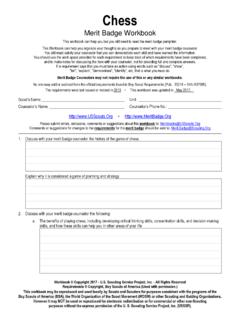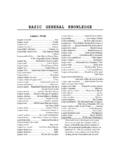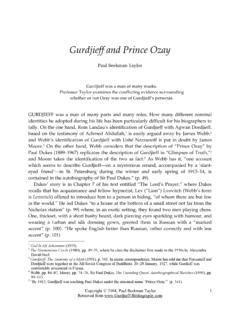Transcription of The long history of gaming in military training
1 SIMULATION & gaming , 40th Anniversary Issue 1 The long history of gaming in military training Roger Smith US Army PEO for Simulation, training , and Instrumentation There is a long history of the dual-use of games in both the military and the entertainment applications. This has taken the form of sand tables, miniatures, board games, and computer games. The current tension between entertainment and military applications of games is just the return of similar concerns that surrounded the gaming tools and technologies of previous generations. Dynamic representations of the physical world are interesting and useful tools in a number of fields, to include the military , city planning, architecture, education, and entertainment.
2 Computer games are tools that allow all of these audiences to accomplish similar goals. KEYWORDS: board game, computer game, sand table, wargame The military has been using games for training , tactics analysis, and mission preparation for centuries. Each generation has had to wrestle with the personal and public image of a game being used for something as serious as planning warfare in which people s lives are at stake. During the opening years of the 21st century, the industry faced a renewed version of this question with the widespread use of computer games taken directly from the entertainment industry. For example, the Americas Army project is based on the Unreal-2 Engine (Davis et al, 2003 and Zyda et al, 2005) from Epic Games and DARPA s DARWARS Ambush product is derived from Operation Flashpoint by Bohemia Interactive Games.
3 Other agencies have converted Doom and Half-Life, or licensed products like Gambryo or the Havok physics engine to create military training systems. The questions, perceptions, and compromises that these projects face today are not new; they have been experienced by previous generations of engineers who attempted to leverage technologies from other domains. The mathematical models, paper board wargames, and miniatures that were adopted in previous centuries were met with the same types of apprehension that computer games face today. This article paints a broad picture of the history of the use of games by the military , the perceptual issues around that use, and the progress that has been made over many centuries. military gaming Ages Stone Age Simulation and gaming as tools of warfare has a long history . At least as far back as the Roman Empire, commanders used sand tables with abstract icons to represent soldiers and units in battle.
4 These allowed leaders to visualize and manipulate a small physical copy of the battlefield. It allowed them to see information in geographic perspective and enabled multiple players to pit their own ideas against one another. Though the visual representation provided the initial value of the practice, creating a playing board upon which multiple options could be compared proved to be even more powerful. These tools allowed leaders and their staff members to compete against each other or against historical records in an attempt to determine which would be the most effective (Perla, 1990). Report Documentation PageForm ApprovedOMB No. 0704-0188 Public reporting burden for the collection of information is estimated to average 1 hour per response, including the time for reviewing instructions, searching existing data sources, gathering andmaintaining the data needed, and completing and reviewing the collection of information.
5 Send comments regarding this burden estimate or any other aspect of this collection of information,including suggestions for reducing this burden, to Washington Headquarters Services, Directorate for Information Operations and Reports, 1215 Jefferson Davis Highway, Suite 1204, ArlingtonVA 22202-4302. Respondents should be aware that notwithstanding any other provision of law, no person shall be subject to a penalty for failing to comply with a collection of information if itdoes not display a currently valid OMB control number. 1. REPORT DATE 2010 2. REPORT TYPE 3. DATES COVERED 00-00-2010 to 00-00-2010 4. TITLE AND SUBTITLE The long history of gaming in military training 5a. CONTRACT NUMBER 5b. GRANT NUMBER 5c. PROGRAM ELEMENT NUMBER 6. AUTHOR(S) 5d. PROJECT NUMBER 5e. TASK NUMBER 5f. WORK UNIT NUMBER 7. PERFORMING ORGANIZATION NAME(S) AND ADDRESS(ES) US Army PEO for Simulation, training , and Instrumentation,12350 Research Parkway,Orlando,FL,32826 8.
6 PERFORMING ORGANIZATIONREPORT NUMBER 9. SPONSORING/MONITORING AGENCY NAME(S) AND ADDRESS(ES) 10. SPONSOR/MONITOR S ACRONYM(S) 11. SPONSOR/MONITOR S REPORT NUMBER(S) 12. DISTRIBUTION/AVAILABILITY STATEMENT Approved for public release; distribution unlimited 13. SUPPLEMENTARY NOTES Simulation gaming February 2010 vol. 41 no. 1 6-19 14. ABSTRACT 15. SUBJECT TERMS 16. SECURITY CLASSIFICATION OF: 17. LIMITATION OF ABSTRACT Same asReport (SAR) 18. NUMBEROF PAGES 12 19a. NAME OFRESPONSIBLE PERSON a. REPORT unclassified b. ABSTRACT unclassified c. THIS PAGE unclassified Standard Form 298 (Rev. 8-98) Prescribed by ANSI Std Z39-18 SIMULATION & gaming , 40th Anniversary Issue 2 The sand tables begat miniature gaming as both a military tool and a form of entertainment.
7 Fred Jane, pioneer of the series of reference books on military weapons data, created the Naval Wargame in 1903 as a military tool and shortly thereafter Wells, the famous author of War of the Worlds, published the book Little Wars in 1913 in which he described the use of miniature tokens and terrain boards for both military training and entertainment. From these roots sprung a century of the use of miniatures in planning military operations. Paper Age Strategy board games made of wood or paper emerged in Asia, the Middle East, and Europe. In Japan, there are ancient references to the game of WEI HAI around 3000 BC, a term that meant encirclement. This game is thought to be the predecessor of the modern game of GO (circa 2300BC). Both of these games used abstract tokens that the player manipulated to gain a territorial advantage over an opponent.
8 CHATURANGA emerged in India in 500BC with a gridded board and pieces that represent the leaders and warriors on a battlefield. It allowed by two-player and four-player games and is the clear predecessor to modern CHESS. It used pieces which explicitly represented the military equipment of the time the chariot, cavalry, elephant, soldier, and Rajah. In its original form, a die was used to select the piece to be moved. But Indian legal restraints on gambling and games of chance were applied to CHATURANGA, forcing its adherents to eliminate the die and allow the players to develop their own strategies for selecting and moving pieces. By 500AD, this game had moved through the Middle East and Europe, being modified into the game of CHESS that we recognize today. Along the way many cultures cast it as the ultimate test of strategic thinking in a military context.
9 The identification of specific pieces, the movement patterns assigned to each, the size of the playing board, and more advanced rules required centuries of experimentation to arrive at their current balance and to create a game that could challenge players for a lifetime and countries for centuries (Shenk, 2007). Though GO, CHATURANGA, and CHESS may still be considered games of strategy, they are no longer accepted as training tools for warfare. The continuous evolution of gaming and training had led to more military -specific tools. In 1664, Christopher Weikmann created KOENIGSPIEL which was one of the earliest board games meant primarily for developing and communicating strategies of warfare. He was followed by Helwig with WAR CHESS in 1780 and Baron von Reisswitz with KREIGSSPIEL in 1811. All of these devices were strictly tools to improve military thinking and to enable military training .
10 During the late 19th century, the United States Naval War College used wargames to plan defenses against a British invasion of New York harbor. The Germans used wargames to plan to invasion of Poland at the beginning of World War II and the Japanese used this tool to plan the attacks on Pearl Harbor (Perla, 1990). By the 1950 s, two independent inventors introduced the paper board wargame with cardboard military markers and a table of combat results for calculating attrition and movement. The RAND Corporation created a system to present theater-level warfare in a form that would allow more mathematically accurate combat than that found on the sand tables and the board games of earlier centuries. They were charged with integrating the effects of the newly created nuclear arsenal, as well as developing strategies for defending against nuclear attack.














